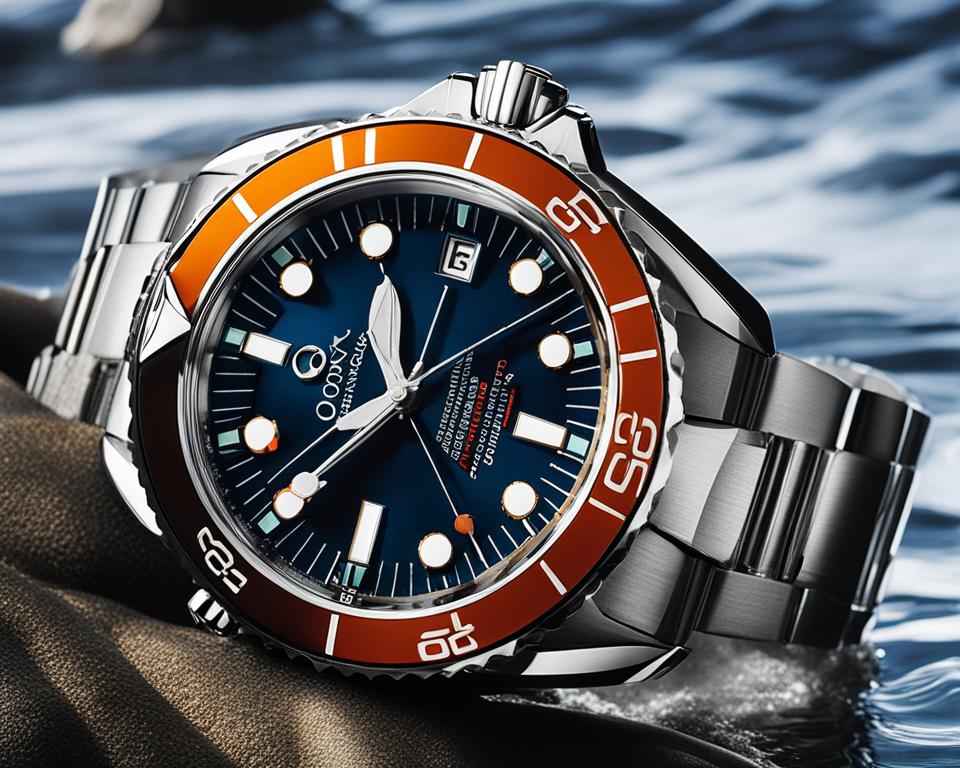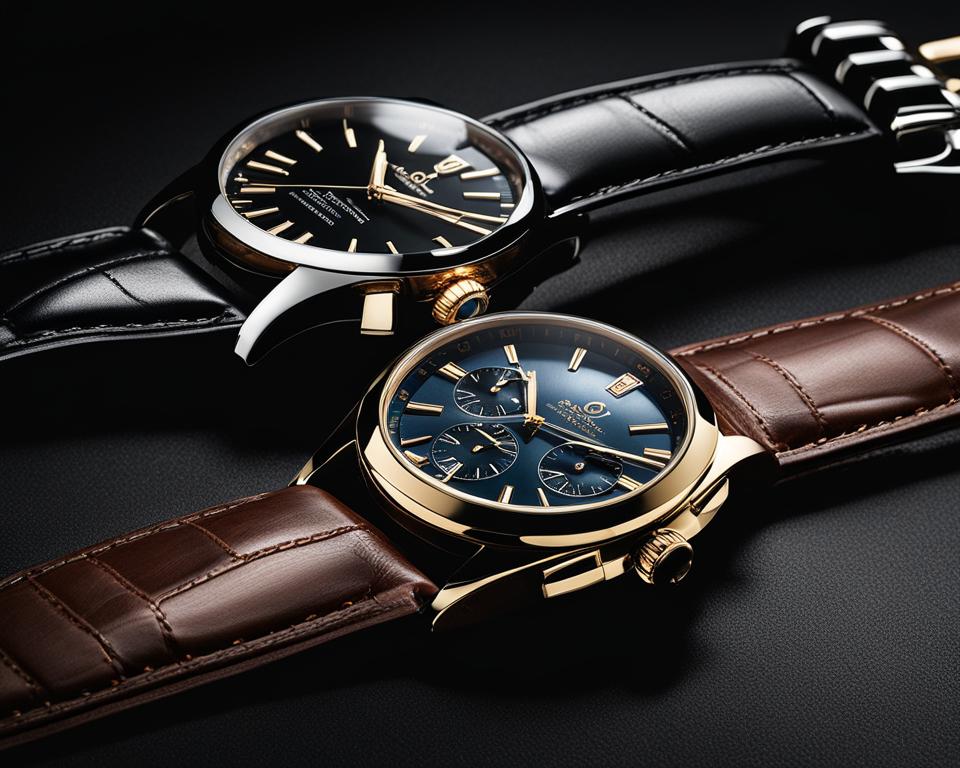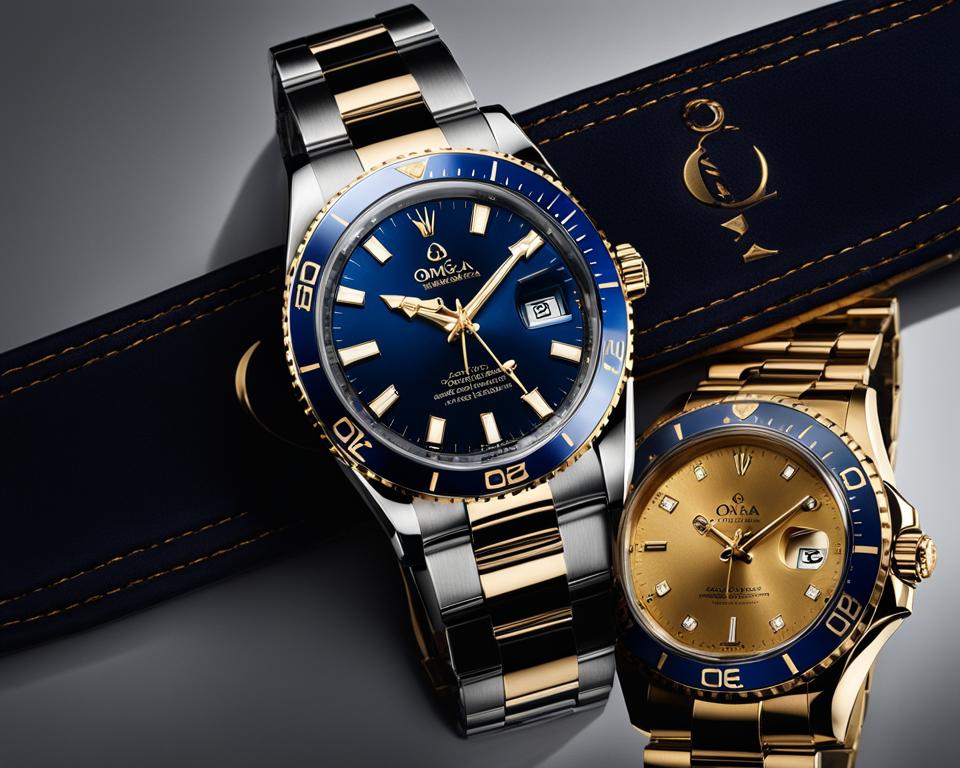As luxury timepieces, Omega and Rolex watches are renowned for their exquisite craftsmanship and timeless appeal. If you’re torn between these two prestigious brands, this article will help you navigate the differences and determine which one suits your style and needs best. Let’s dive into a detailed comparison of Omega and Rolex watches.
Key Takeaways:
- Both Omega and Rolex are highly regarded luxury watch brands.
- Omega has a rich history, including being the first watch on the moon, while Rolex is associated with iconic moments such as mountaineering and channel swimming.
- Omega’s Co-Axial movements offer reduced friction and improved accuracy, while Rolex produces its own Perpetual movements.
- Omega’s diver’s watches, like the Seamaster ProProf 1200m, offer impressive water resistance, while Rolex’s Deepsea series stands out with extreme water resistance up to 3,900 meters.
- Omega offers both quartz and mechanical watches, with quartz watches being more accurate, while Rolex focuses solely on mechanical watches.
- Rolex watches generally have a higher price range and better resale value compared to Omega watches.
The History and Prestige of Omega and Rolex
Omega and Rolex are two iconic luxury watch brands with a rich history and enduring prestige. Let’s dive into the fascinating stories behind these renowned timepiece manufacturers.
The Legacy of Omega:
Founded in 1848 in Switzerland, Omega has a long-standing tradition of excellence in watchmaking. The brand’s history is intertwined with significant events and achievements, such as its association with the Olympic Games since 1932, where Omega serves as the official timekeeper. Omega’s timepieces have been trusted to measure and record the performances of the world’s greatest athletes.
Another milestone in Omega’s history is its connection to the legendary secret agent, James Bond. Since 1995, Omega watches have graced the wrist of 007 in multiple Bond films, cementing the brand’s status as a symbol of sophistication and precision. And let’s not forget Omega’s crowning achievement – the first watch worn on the moon. During the Apollo 11 mission in 1969, astronaut Buzz Aldrin proudly sported an Omega Speedmaster, forever etching the brand’s name in the annals of space exploration.
The Timeless Tales of Rolex:
Rolex, established in 1905, has carved its own path of distinction in the luxury watch industry. The brand has been associated with numerous historic moments, from Sir Edmund Hillary’s conquest of Mount Everest in 1953 while wearing a Rolex Oyster Perpetual, to Mercedes Gleitze’s groundbreaking swim across the English Channel, where a Rolex Oyster became the first waterproof wristwatch to complete the challenging journey.
Rolex’s legacy of extraordinary achievement continues to this day. The brand’s watches have accompanied explorers, world leaders, and visionaries on their quests for greatness. With its unwavering commitment to precision, reliability, and innovation, Rolex has solidified its reputation as a symbol of success and elegance.
Both Omega and Rolex hold a position of immense prestige in the watch industry, thanks to their remarkable histories and unwavering dedication to craftsmanship. These brands continue to be coveted by enthusiasts and collectors alike, with their watches serving as timeless symbols of style, achievement, and exceptional Swiss engineering.
Movements: Omega’s Co-Axial vs Rolex’s Perpetual
When it comes to the movements used in their watches, Omega and Rolex each have their unique approaches. Omega utilizes its proprietary Co-Axial calibers, which offer several advantages over traditional movements. These Co-Axial calibers are designed to reduce friction, resulting in improved accuracy and longer service intervals. The reduced friction also leads to less wear and tear on the movement components, ensuring a longer lifespan for the watch.
On the other hand, Rolex focuses on producing its own mechanisms and is renowned for its Perpetual movements. Rolex’s Perpetual movements are designed with precision and efficiency in mind, and they are certified as chronometers for their accuracy. These movements are known for their reliability and stability, allowing Rolex watches to maintain consistent timekeeping over extended periods.
The Advancements: Omega Master Chronometer and Rolex Caliber 3235 and 3255
In recent years, both Omega and Rolex have introduced new advancements in their movements. Omega unveiled its Master Chronometer family, which includes watches that have undergone rigorous testing and received certification from independent institutes such as METAS. These Master Chronometer watches offer enhanced accuracy and magnetic resistance, providing a high level of performance.
Similarly, Rolex introduced the Caliber 3235 and 3255 movements, which incorporate several innovations to improve accuracy, dependability, and power reserve. These movements feature Rolex’s patented Chronergy escapement system, which increases the efficiency of energy transfer and extends the power reserve. With these advancements, Rolex continues to push the boundaries of mechanical watchmaking.
Both Omega and Rolex have made significant strides in their movements, showcasing their dedication to advancing the art of horology. Whether you prefer Omega’s Co-Axial calibers with reduced friction or Rolex’s Perpetual movements with their chronometer certification, both brands offer exceptional craftsmanship and precision in their timepieces.
Water Resistance: Omega’s Diver’s Watches vs Rolex’s Deepsea
When it comes to water resistance, both Omega and Rolex have established themselves as leaders in the luxury watch industry. Their diver’s watches are specifically designed to withstand the rigors of underwater exploration. Let’s take a closer look at the water resistance capabilities of Omega’s dive watches and Rolex’s Deepsea series.
Omega offers a range of impressive dive watches that are built to withstand the depths of the ocean. One notable model is the Omega Seamaster ProProf 1200m, which boasts an impressive water resistance rating of 1,200 meters. This timepiece is specifically designed for professional divers who need a watch that can perform flawlessly in extreme underwater conditions. Additionally, Omega’s Seamaster Planet Ocean and Professional Diver 300M models also offer substantial water resistance, making them suitable for recreational divers as well.
On the other hand, Rolex’s Deepsea series takes water resistance to the next level. These watches are built to withstand the most extreme underwater conditions and are capable of diving to depths of up to 3,900 meters. The Rolex Deepsea is equipped with a helium escape valve, which allows the watch to release built-up pressure during decompression. This feature ensures the watch’s durability and performance even in the most challenging diving environments.
Key Points:
- Omega offers dive watches with water resistance up to 1,200 meters.
- Rolex’s Deepsea series can withstand depths of up to 3,900 meters.
- Omega’s Seamaster Planet Ocean and Professional Diver 300M models also have substantial water resistance.
- Rolex Deepsea watches are equipped with a helium escape valve for added durability.

Both Omega and Rolex have proven their commitment to creating timepieces that can perform flawlessly in underwater environments. Whether you choose Omega’s exceptional dive watches or Rolex’s Deepsea series, you can be confident that your watch will withstand the challenges of the deep sea. The decision ultimately comes down to personal preference and the specific needs of your diving adventures.
Accuracy: Omega’s Quartz and Mechanical vs Rolex’s Mechanical
In terms of accuracy, Omega offers a range of watches with different movement types, including quartz and mechanical. Omega’s quartz watches are known for their exceptional precision, relying on quartz crystals to maintain accurate timekeeping. These watches typically have a battery-powered movement and require less maintenance compared to mechanical watches.
On the other hand, Rolex focuses solely on producing mechanical watches. These watches are powered by intricate, self-winding mechanisms that rely on the natural motion of the wearer’s wrist to keep time. While mechanical watches may not be as accurate as quartz watches, they are known for their craftsmanship and the intricate engineering that goes into their movements.
For those who prioritize absolute accuracy, Omega’s quartz watches offer a reliable option. The use of quartz technology ensures precise timekeeping, making them a practical choice for individuals who require precise measurements in their daily activities. However, many watch enthusiasts are drawn to the artistry and traditional craftsmanship of mechanical watches, appreciating the mechanical complexity and the timeless appeal they offer.
Omega Quartz Watches:
- Precision timekeeping
- Low maintenance
- Reliable battery-powered movement
Omega Mechanical Watches:
- Traditional craftsmanship
- Intricate self-winding mechanisms
- Long-lasting mechanical movements
Rolex Mechanical Watches:
- Superior craftsmanship
- Intricate self-winding movements
- Timeless appeal

Price and Resale Value: Omega vs Rolex
When it comes to luxury watches, price and resale value are significant factors to consider. In the battle between Omega and Rolex, each brand has its own unique pricing structure and resale value.
Price Comparison
Omega watches generally have a lower price range compared to Rolex. Omega offers a range of models with prices starting at around $3,000 and going up to approximately $8,000. On the other hand, Rolex watches are generally priced higher, with models ranging from $6,000 to $20,000.
It’s important to note that both Omega and Rolex offer premium craftsmanship and quality, regardless of the price range. The decision between the two brands ultimately comes down to personal preference and budget.
Resale Value Evaluation
When it comes to resale value, Rolex is considered the top brand in the luxury watch market. Rolex watches have a reputation for retaining their value exceptionally well over time. This is due to various factors, including Rolex’s strong brand image, high demand, limited supply, and consistent quality.
While Omega watches also have a respectable resale value, they do not match the level of Rolex in terms of long-term investment potential. However, it’s worth noting that Omega’s resale value is still considerably higher than many other luxury watch brands in the market.
Ultimately, if resale value is a significant consideration for you, Rolex may be the better choice. However, if you’re more focused on upfront affordability without compromising quality, Omega offers a compelling option.
Conclusion: Choosing Between Omega and Rolex
When it comes to deciding between Omega and Rolex, the choice ultimately boils down to personal preference and priorities. Both brands offer exceptional quality, craftsmanship, and a long-standing reputation in the luxury watch industry. However, there are key factors to consider in order to make an informed decision.
Omega watches are known for their durability and lower price range, making them a sensible choice for most customers. With a wide range of models to choose from, Omega offers a variety of features, movements, and designs to suit different styles and needs. Whether you’re looking for a reliable timepiece for everyday wear or a robust diver’s watch for underwater exploration, Omega has a watch to meet your requirements.
On the other hand, Rolex excels in prestige and resale value. With a higher price range, Rolex watches are often considered a symbol of luxury and exclusivity. The brand’s meticulous craftsmanship, attention to detail, and iconic designs have made Rolex watches highly sought after by collectors and enthusiasts worldwide. Owning a Rolex watch not only allows you to enjoy the artistry and precision engineering, but it also serves as an investment that can retain its value over time.
In conclusion, choosing between Omega and Rolex ultimately depends on your personal preferences and what you value most in a luxury watch. If durability, versatility, and a more affordable price range are your priorities, Omega is an excellent choice. If prestige, heritage, and exceptional resale value are what you seek, Rolex is the brand that delivers. Whichever brand you choose, both Omega and Rolex offer timepieces that are not only functional but also pieces of art to be treasured for generations.
FAQ
What are the main differences between Omega and Rolex watches?
The main differences between Omega and Rolex watches include their history and prestige, movements, water resistance, accuracy, pricing, and resale value.
What is the history and prestige of Omega and Rolex?
Omega has a rich history of producing watches for prestigious events like the Olympic Games and James Bond movies, while Rolex has been associated with iconic moments such as summiting Mount Everest and swimming across the English Channel.
What are the movements used in Omega and Rolex watches?
Omega uses their proprietary Co-Axial calibers, while Rolex produces their own mechanisms and utilizes the Perpetual movements. Both brands have introduced new movements in recent years that offer enhancements in accuracy and dependability.
How do Omega and Rolex watches compare in terms of water resistance?
Omega offers diver’s watches with impressive water resistance, such as the Seamaster ProProf 1200m, while Rolex has the Deepsea series with even higher water resistance up to 3,900 meters.
Are Omega or Rolex watches more accurate?
Omega offers both quartz and mechanical watches, with quartz watches being more accurate. Rolex focuses solely on producing mechanical watches, prioritizing artistry over absolute accuracy.
How do Omega and Rolex compare in terms of price and resale value?
Rolex watches are generally priced higher than Omega watches, but Rolex has the highest global resale value in the used watch market.
How do I choose between Omega and Rolex?
The choice between Omega and Rolex depends on personal preference and priorities. Omega offers exceptional quality and durability at a lower price range, while Rolex excels in prestige and resale value.

Leave a Reply